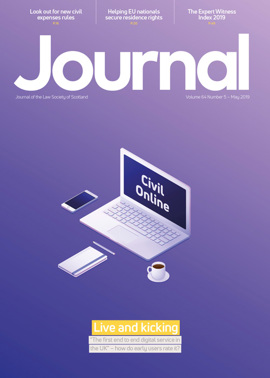Enter the “What I Think”

The procedures for seeking the views of children in actions requesting orders under s 11 of the Children (Scotland) Act 1995 (“s 11 orders”) are changing.
One long-awaited change is to the forms intimated to a child to seek views (form F9 in the Sheriff Court and form F49.8A in the Court of Session). Now called “What I Think” forms, these have been revamped to make them more child-friendly in language and appearance.
Court control
In terms of procedures, the Act of Sederunt modifies chapters 33 and 33A of the Ordinary Cause Rules 1993 and chapters 49 and 70 of the Rules of the Court of Session 1994, to identical effect (allowing for procedural differences).
Where a s 11 order is sought in a new action, warrant to intimate form F9 on the child, or to dispense with such intimation if it would be inappropriate to seek the child’s views, must still be sought in the initial writ (or by motion in the Court of Session), notice of intention to defend (NID) or defences. However, the draft form F9/49.8A must now be submitted to the court when the writ is presented for warranting/signeting or NID/defences are lodged. The court “must be satisfied that the form… has been drafted appropriately”, which is likely to mean that it is written in child-friendly language and presents the proposed order in neutral terms. It is unclear what will be done if the court is not so satisfied, but the new certificate of intimation of form F9A/49.8A refers to the court having ordered an amendment to the form, suggesting this is the approach which may be taken.
The new rules also introduce procedures and timescales for executing warrant to intimate on a child. If only the pursuer seeks a s 11 order, the approved form F9 must be intimated no later than 14 days after the lodging of a NID (that is, once it is known the action will be defended). If only the defender seeks such an order, the form F9 must be intimated on the child no later than 14 days after lodging of the NID (or if the action is raised in the Court of Session, after lodging defences). A certificate of intimation must be lodged on the same day.
If both parties seek s 11 orders, the pursuer must amend the approved form F9 “so as also to narrate the s 11 order sought by the defender”, and intimate this on the child no later than 14 days after the NID is lodged. There appears to be no requirement to adjust the revised form F9 between parties, or to seek the court’s approval of the amended version. Finally, a new provision is added enabling the court to order a form F9 to be sent/resent to a child “at any time” where “the passage of time requires it”. This may be appropriate where the views of the child may have changed, or he or she has become old enough to express a view.
Further changes
Other aspects of the role of the court are clarified by the new rules. The court must now consider whether, and if so how, to obtain the child’s views before making an interim s 11 order. Changes are also made to the procedure for ordering child welfare reports. A direction must be made as to whether any views ought to be recorded in a separate report; and if so, whether or not that should be provided to the parties.
Procedures in relation to applications after final decree are also covered by the rule changes. All applications for s 11 orders in such actions shall now be made by minute, removing the procedural distinction in the Court of Session between contact orders and other types of s 11 orders. The procedures for seeking views in such applications mirror those for new actions.
Finally, the rule changes also cover the procedure to be followed in petitions under the Child Abduction and Custody Act 1985 (chapter 70 of the Rules of the Court of Session). The procedures mirror those set out above. The existing form 49.8-N used for seeking views in such cases is discontinued and views will now be sought using the revised form 49.8A used in s 11 cases.
In this issue
- Claiming under the advance payment scheme
- Time for a written constitution
- New form F9: worth the wait?
- Wedded to a matrimonial property regime
- Brexit divorce set to increase UK's “skype families”
- Corporate personality: Justice v Doctrine
- Reading for pleasure
- The Law Society of Scotland Expert Witness Index 2019
- Opinion: Judith Robertson
- Book reviews
- Profile: Michael Clancy
- President's column
- Is your legal data being held to ransom?
- People on the move
- Sign up – log in – action!
- Frozen out?
- Taxing times for litigators
- DNA analysis: when research just isn’t enough
- Brexit focus: EU citizen settlement remedies
- Why employers should report on wellbeing
- 3% – and then what?
- 1,000 days of mediation
- Barred from acting
- To name or not to name?
- Enter the “What I Think”
- Fixed penalties and fair trials
- Auto-enrolment: keeping employers on their toes
- Scottish Solicitors' Discipline Tribunal
- Vulnerable accused: a need for knowledge
- Burdens and who can enforce them
- Convener’s final bow
- Public policy highlights
- TCSP review update
- Westminster: answering the call
- Accredited paralegal practice area highlight: family law
- Accredited Paralegal Committee profile
- Nyona named star paralegal
- Ask Ash
- Moving nightmares part 2
- Complaints: seeking consistent practice
- Morally bankrupt?
- For the elderly: how SFE works
- Standing up to challenge






